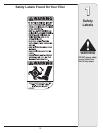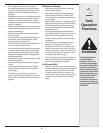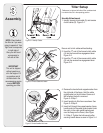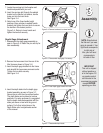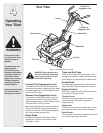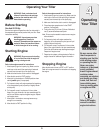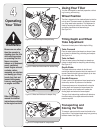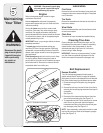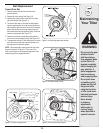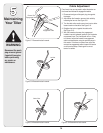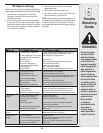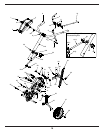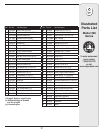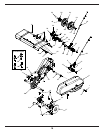
11
Tilling Procedure
When tilling, leave approximately eight inches of untilled
soil between the first and second tilling paths, then make
the third path between the first and second, Figure 4–7.
In some soils, the desired depth is obtained the first
time over the garden. In other soils, the desired depth
is obtained by going over the garden two or three times.
Passes should be made across the length and width of
the garden alternately. Rocks which are turned up should
be removed from the garden area.
With the outer tines installed, the working width of the
machine is 24 inches. This width may be expanded to
26 inches by removing the clevis and cotter pins, sliding
each outer tine outward away from the center of the unit
and resecuring the pins in the holes provided.
See Figure 4–8.
Removing End Caps
The end cap, which is used to avoid tilled soil from
overflowing onto unwanted areas, are removable from the
axle. Remove the hairpin clip and clevis pin that secure
each end cap and slide the end caps off the axle.
See Figure 4–9.
Figure 4–7: Recommended tiller paths.
Cultivating
For cultivating, a two to three inch depth is desirable.
The tine width can be reduced to 13 inches by removing
the outer tines completely from the tiller. See figure 4–8.
When laying out plant rows, be sure to allow enough
width to permit cultivation between the rows. In growing
corn or similar crops, check-row planting will permit cross
cultivation and practically eliminate hand hoeing.
Figure 4–10.
The tiller has many uses other than tilling and cultivating
a garden. One of these is the preparation of lawn area for
seeding. The tiller will prepare a deep seed bed which will
be free of hard untilled spots, allowing a better stand of
grass to grow. The tiller is very useful for loosening hard
soil for excavation with a shovel; No tedious handwork
will be necessary. Your tiller may be used for mixing
compost in the pile or for mixing it with the soil in your
garden. This should be done after the soil has been
broken to the full working depth. The compost should be
worked in to a depth of six to seven inches. This may be
done by working the length of the garden and then by
making separate passes across its width. The addition
of decayed organic matter will substantially increase
the fertility of your garden. For proper decaying action,
fertilizer should be applied and worked in with the mulch
materials. Breaking up leaves and straw and mixing it with
several inches of soil allows proper aeration of the plant
root system and retards the growth of weeds.
4
Operating
Your Tiller
WARNING
Be sure no one other
than the operator is
standing near the tiller
while starting engine
or operating the unit.
Never run engine
indoors or in enclosed,
poorly ventilated
areas. Engine exhaust
contains carbon
monoxide, an odorless
and deadly gas. Keep
hands, feet, hair and
loose clothing away
from any moving parts
on engine and tiller.
Refer to the engine
manual for detailed
instructions pertaining
to engine controls.
Figure 4–9: Removing end caps.
4 5 2 3 1
Figure 4–10: Allow area between rows for cultivation.
Figure 4–8: Moving and removing outer tines.



